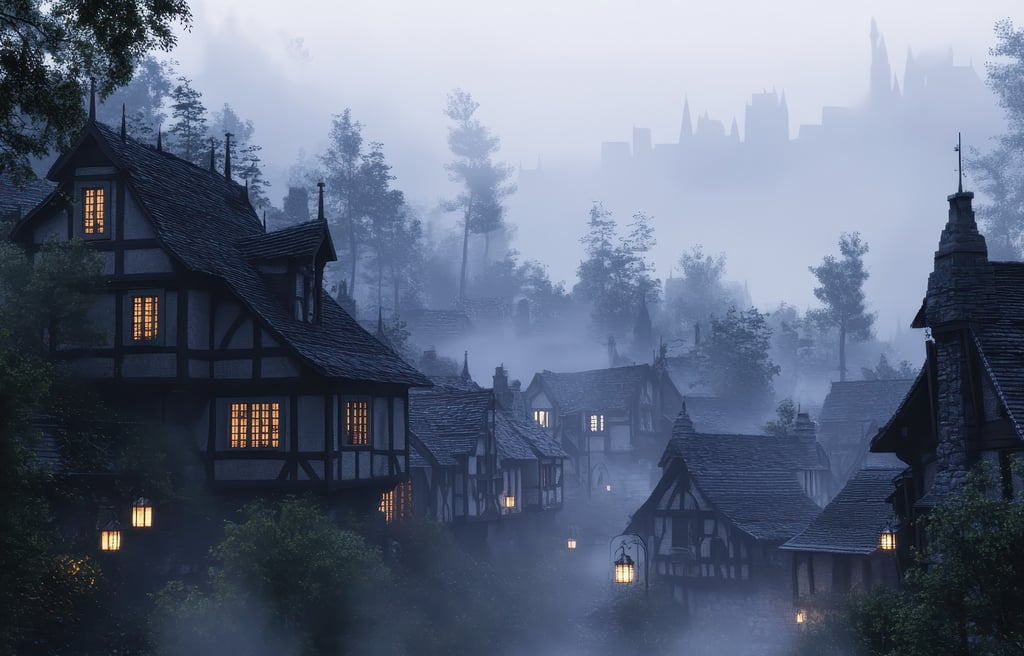The Heart of Medieval Life: The European Village
Journey beyond the castles and cathedrals to the true heart of the Middle Ages: the village. This short history explores the humble, self-sufficient communities where over 90% of the medieval population lived, worked, and died. Discover how they emerged from the ruins of the Roman Empire, how the manorial system and open fields shaped daily life, and how catastrophic events like the Black Death forever changed their world. Uncover the enduring legacy of the European medieval village, the foundation upon which modern life was built.
8/21/20253 min read


For the vast majority of people in the Middle Ages (c. 500-1500 AD), life was not defined by castles, cathedrals, or cities, but by the village. These small, self-sufficient communities were the economic and social engines of the feudal world, housing over 90% of the population. Their story is one of adaptation, communal living, and slow transformation.
Origins: The Legacy of Rome and Insecurity (5th-9th Centuries)
With the fall of the Western Roman Empire, the long-distance trade and security it provided disintegrated. The former Roman villas (large agricultural estates) were often abandoned or taken over by local warlords. People sought safety and stability, leading to the formation of new, smaller settlements.
Germanic Influence: Incoming Germanic tribes like the Franks, Angles, and Saxons often settled in small, kinship-based hamlets, a pattern different from the Roman centralized estate.
Insecurity: The threat of Viking raids, Magyar incursions, and general lawlessness forced many peasants to seek the protection of a local lord, in exchange for their labor and loyalty. This was the birth of the manorial system.
The Classic Medieval Village (c. 1000-1300)
The period from the year 1000 onwards saw relative climatic improvement (the Medieval Warm Period) and greater political stability. This led to a population boom and the consolidation of the village pattern we most associate with the era.
Key Features:
The Manor: The village was not an independent entity. It was the economic unit of a manor, an estate owned by a lord (whether a knight, a baron, or the Church). The village and its surrounding fields were his property.
Open Field System: The most common agricultural arrangement, particularly in England and Northern France. The land was divided into two or three large open fields. These were then split into many long, narrow strips. Each peasant family would farm dozens of these strips scattered across different fields, ensuring everyone got a share of good and bad soil.
Communal Life and Law: Survival depended on cooperation. The village decided collectively when to plant, when to harvest, and how to manage the common pasture and woodland where animals grazed. A villein (a serf bound to the lord) owed several days of labor each week on the lord's own land (the demesne), using the village's common plow team.
Layout: A typical village consisted of a cluster of small, simple peasant homes made of wattle and daub (woven wood and mud) with thatched roofs. These lined a single street or clustered around a green. At the center were often the most important structures:
The Manor House: The lord's residence.
The Church: The spiritual heart of the community.
The Mill: Owned by the lord; peasants were required to pay to grind their grain there.
The Common Oven: Another manorial monopoly.
Daily life was hard, monotonous, and intimately tied to the seasons and the soil.
Crisis and Change (14th-15th Centuries)
The 14th century brought a series of catastrophes that shattered the manorial system and transformed village life forever.
The Black Death (1347-1351): This was the single most devastating event. It killed between one-third and one-half of Europe's population. With a severe labor shortage, surviving peasants found their bargaining power increased. They could demand wages for their work and challenge the old feudal obligations.
Abandoned Villages (Wüstungen): Many villages, especially those on marginal land, were completely wiped out by the plague or subsequent outbreaks and never repopulated. Their ghostly outlines can still be seen in fields from England to Germany.
Peasant Revolts: Empowered by their new scarcity and angry at lords trying to re-impose old feudal dues, major revolts erupted across Europe (e.g., the English Peasants' Revolt of 1381, the Jacquerie in France).
The Legacy of the Medieval Village
The old system of serfdom and open fields did not disappear overnight, but it went into terminal decline. Lords began to enclose their fields for more profitable sheep farming, and a new class of yeoman farmers emerged who rented land for cash.
The medieval village laid the groundwork for modern Europe. Its fields often dictate the modern countryside's patchwork layout. Many of today's towns and cities began as medieval villages that grew. Most importantly, it was in these small, tightly-knit communities that traditions, local governance, and a sense of communal identity—the direct ancestors of modern European cultures—were forged and preserved for a thousand years.
Contact us
Copyright © 2025. Ralnoscape All rights reserved.
Destinations
Resources


Follow us
This website uses affiliate links which may earn a commission at no additional cost to you
